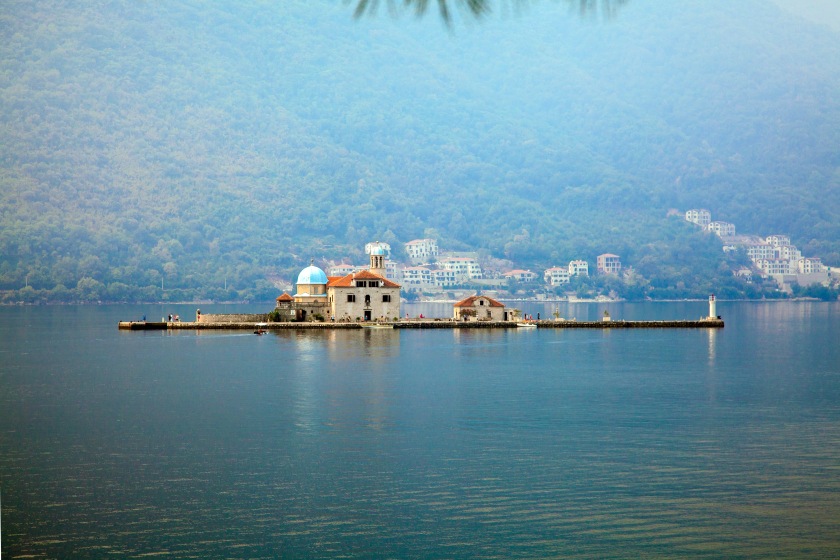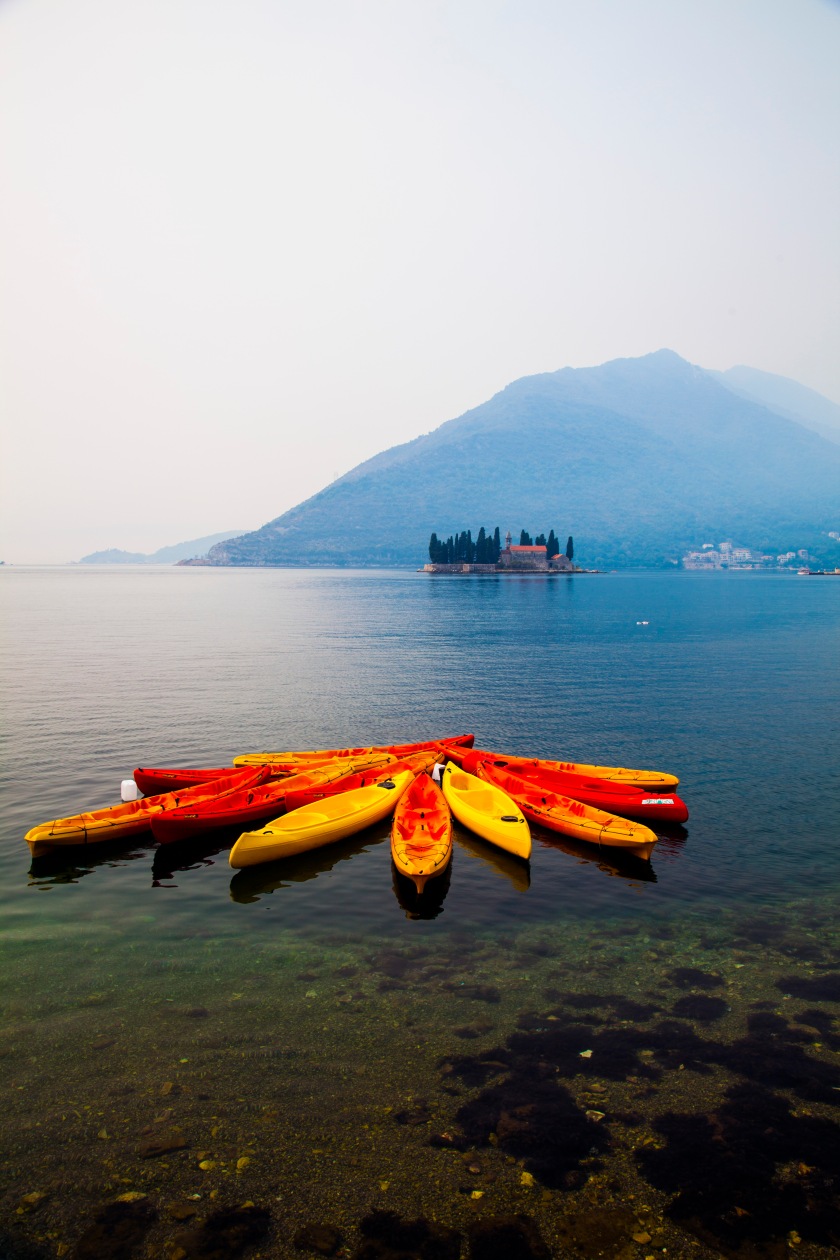РУССКОЯЗЫЧНАЯ ВЕРСИЯ ПО ЭТОЙ ССЫЛКЕ. CLICK HERE FOR RUSSIAN VERSION.
30 August 2012 – Thursday
Today, by contrast, was a very active day: we took the long-awaited trip to Montenegro. The mountain forest road, which took us quite long to drive through until the border, was indeed beautiful, but the day was extremely hazy. At first we thought it was fog, but then it turned out that it was the smoke from forest fires in Bosnia. We were told that the situation was really critical there, so a few sections of Croatian firefighters were sent for help.
In general, our guide Petra told us a lot of things, mostly about Croatia, though. For example, we learned that the Lokrum island (very close to Dubrovnik), famous for its parks and entertainment, had been cursed. A very soon death is believed to await anyone who stays there overnight. The superstitious Dubrovnikers still believe in this, so every day the last, eight o’clock boat to the city is fully packed with people hurrying to leave the island.
We also learned that Dubrovnikers do not like to rent housing, but tend to buy it instead – so they feel safer. In this case, they have to take mortgage loans for 30-40 years because of very high cost of real estate.
Driving further up in the mountains, we saw three islands from up high: Mrkan (St. Martin), Bobara (St. Barbara) and Supetar (St. Peter’s). In the 14th century, first quarantines in history were located on them, and all those traveling to Dubrovnik (then Ragusa) were required to spend 40 days there, hence the name (from the Italian word “quaranta” – “forty”). Owing to this, plague spread very little in Dubrovnik.
Driving past Konovle, we heard about the fertility of these lands. Here exists a kind of black market for vegetables here: there are women working on the fields, referred to as “our ladies”, who can be called any time and asked to deliver fresh vegetables, which they will do the same day (or, the latest, the next morning), bypassing shops and markets.
We got slightly anxious, approaching the Montenegrin border, and took out our passports and insurance documents in advance. But everything went smoothly and no one got into the bus to check anything – Petra sorted everything out by herself.
Generally, the difference between Croatia and Montenegro can be noticed immediately: Montenegro seems poorer, the houses are more dilapidated, there are lots of signs in Cyrillic script (they use both Latin and Cyrillic scripts here) and in Russian too.
The official currency is euro, even though Montenegro is not part of the EU and not going to be one in the foreseeable future. There is an explanation. This area is located at the junction of the Eurasian and African tectonic plates, which results in frequent earthquakes. After one of such earthquakes in the second half of the XX century, Montenegro had to borrow money from Germany for rehabilitation and reconstruction. When in the 80’s Yugoslavia suffered an economic crisis and, therefore, a high inflation, Montenegro, in order to pay off the debt in German marks, asked for permission to make them their local currency. After Germany switched to euro, so did Montenegro. However, the government does not have the right to print money, it still gets it from Germany.
In general, we were told that the highlanders and the seaside residents were like two different nations. The highlanders used to lead an austere life, and very often, especially during the Second World War, when a family was left without men, some women had to take on the role of head of the family. These women, called “virdžina” (i.e. “virgin”), dressed like men, carried weapons, talked about themselves in the masculine, were always in the company of men, and only performed men’s duties around the house. Nowadays this tradition has practically disappeared. As for the seaside residents, they, in particular Kotorians, used to be were very educated (education was received by both young men and women, even from common families) and looked down upon the highlanders.
When the Boka Kotorska (Kotor Bay) eventually appeared in sight, we were really disappointed: in the haze it looked like a decal, devoid of any colors, moreover, the fog was so thick that we couldn’t see almost anything. We were taken to a place which was supposed to have a magnificent view and where we could take photos of the Kotor Bay. But there wasn’t much to take pictures of.
And so, sad and disappointed, we drove to a place called Risan, famous for its Roman mosaics. There are the remains of an ancient Roman villa, which has fragments of these mosaics on the floor.
Near the town of Perast we boarded a boat and headed to a small man-made island called Gospa od Škrpjela (Our Lady of the Rocks) with a church of the same name. The origin of the island is rather interesting. For some reason, the Catholics in this area did not have their own church. But once, as legend says, a fisherman found an icon on a rock right in the middle of the Bay. This was considered to be a sign from God, so since then fishermen would throw more and more rocks one on another, after returning from each successful journey and also sank their old ships, loaded with stones. That is how the island was built. The tradition to throw rocks still exists – every year, on the day when the icon was found, local people throw more rocks. The church looks very nice inside, with many beautiful canvas by a famous local painter Tripo Kokolja. The altar is made of several kinds of marble, the most rare and expensive of which was exchanged for silver on a kilogram per kilogram basis.
As we were driving down towards Kotor, Petra told us of some humorous stereotypes which people of the former Yugoslavia have about each other. Thus, the stereotypes are that the Croats are very good singers, but also are too arrogant, the Bosniacs have great sense of humour, but are not particularly bright (sorry, don’t mean to offend anyone – these are not my words, but those of a Croat lady after all!), and the Montenegrins are very lazy. There is even a joke about a competition on who can lie on the road for the longest time. After 24 hours, the competition had to be stopped because the three participating Montenegrins were still lying there with no intention of getting up in the near future. We were shown a card with ten funny Montenegrin Commandments:
In Kotor we were passed to a Russian guide (a lady named Katya, from St. Petersburg, living here for seven years). Very quickly, she walked us around the Old City, as we only had two hours of free time, including a guided tour and lunch. The Kotor city walls are located high in the mountains, and we didn’t get to climb up there. The Old City has plenty of churches and monasteries, the first music school in the Balkans, the first theatre (now it has been sold to become a hotel, so there is no theatre in Kotor anymore). There are both Catholic and Orthodox churches here, but the Catholic ones are more in number – as there are more Catholics here, although generally the majority of Montenegrins are Orthodox. In tough times, many churches had a Catholic and an Orthodox altar at the same time, i.e. were open for both confessions.
Along with other memorable places, our attention was brought to the Pima Palace on the Flour Square. Head of the Pima family used to be one of the largest grain traders here.
Interestingly, in contrast to Dubrovnik, the buildings here are necessarily located at an angle to each other – it was believed that locating them in a row would bring bad luck.
The Kotorians are most proud of the fact that they never were under the Ottoman Empire, even though in their history they used to be subordinate to Venice, were occupied by a Napoleon’s general and by Italian fascists (for two months). On this occasion, we heard a story how Jesus Christ appeared to a girl named Katarina from a mountain village and told her that in two hundred years, the Turks would attack Kotor. The girl didn’t hesitate to come down from the mountains with her mother to warn the Kotorians about the danger. The latter immediately started building a wall to protect their land, succeeded in this and, when the the Turks did attack, they managed to parry the enemy’s strike. Katarina herself had become a nun. In appreciation, her relics were later transferred to the Church of St. Clara, right here, so that the saint would continue to defend the citizens.
By the way, her descent from the mountains was no big deal – we were informed that some inhabitants of the mountain village Njeguši do it every day when delivering products to Kotor.
Driving out of Kotor, we saw a beautiful town on the other side of the bay (the fog had already cleared a little) – either Muo or Prčanj, where we weren’t taken. There was no time left for bathing either, although there were beaches here and there.
On the way back we were told that during the previous tour a few days before, the car queue on the border was seven kilometres! The most thorough shakedowns are usually undergone by those with Albanian and Kosovar passports – this road is actually a drug “Silk Road”. Recently the guards caught a couple in a car with German plates, transporting drugs for the sum of 10 million euros. But this time we were lucky, there was only one bus ahead of us, from Ukraine, which took quite a long time to check though.


















